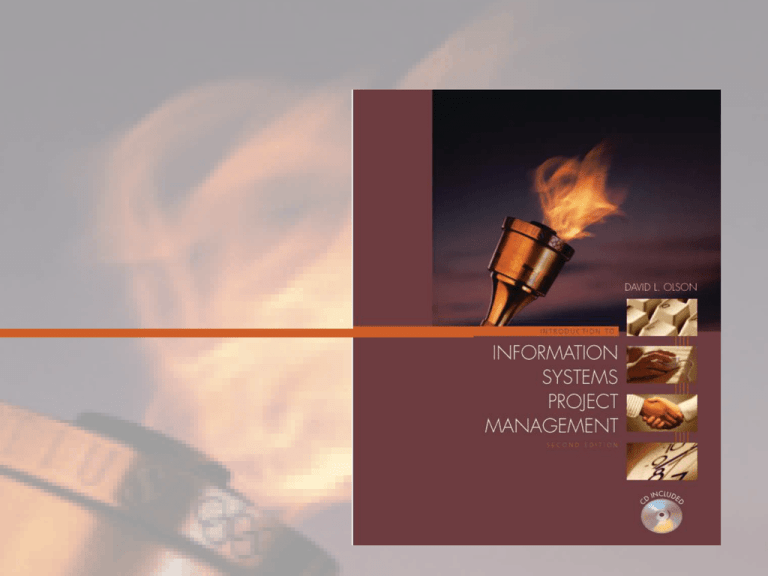Information Systems Project Management—David Olson 10-1 © McGraw-Hill/Irwin 2004
advertisement

Information Systems Project Management—David Olson 10-1 © McGraw-Hill/Irwin 2004 Information Systems Project Management—David Olson 10-2 Chapter 10: Project Implementation State of IS project success critical success factors key IS project factors Need for User Training © McGraw-Hill/Irwin 2004 Information Systems Project Management—David Olson 10-3 State of IS Projects • Most IS projects fail to some degree – time, cost, technical performance • Usually don’t know until late in the project – testing the least predictable project element – everything seems fine until the end © McGraw-Hill/Irwin 2004 Information Systems Project Management—David Olson 10-4 ERP & Hershey’s Supply Chain Stedman [1999] Osterland [2000] Songini [2000] © McGraw-Hill/Irwin 2004 Information Systems Project Management—David Olson 10-5 History • 1997 Hershey’s adopted a $110 million ERP system – SAP R/3 – Siebel CRM – Manugistics logistics package • To replace many legacy systems • Original 4 year project – Compressed to 30 months to precede Y2K – July 1999 three months behind schedule – Adopted big-bang approach to beat deadline © McGraw-Hill/Irwin 2004 Information Systems Project Management—David Olson 10-6 Hershey Business • Very seasonal – Halloween, Thanksgiving • Sept 1997 serious order processing & shipping problems – – – – – Shipping delays Sent incomplete deliveries Delivery time formerly 5 days, with ERP 12 days Sales revenue dropped 12% from prior year Inventory piled up at Hershey warehouses © McGraw-Hill/Irwin 2004 Information Systems Project Management—David Olson 10-7 Problem Diagnosis • Attempted ERP implementation in supply chain environment – That can be done – Confounding factors • During peak season • Tried to do too much as once • Complexity from CRM & Logistics Planning addons • Time pressure © McGraw-Hill/Irwin 2004 Information Systems Project Management—David Olson 10-8 Supply Chain & ERP • Can be done • Hershey’s was a bleeding edge pioneer • Hershey’s seems to have solved problems © McGraw-Hill/Irwin 2004 Information Systems Project Management—David Olson 10-9 Failure Types • Corresponding Failure – fail to meet design objectives • Process Failure – on time & within budget • Interaction Failure – system not used • Expectation Failure – doesn’t meet stakeholder expectations © McGraw-Hill/Irwin 2004 Information Systems Project Management—David Olson 10-10 Reasons for IS Project Failure Engler (1996) • Lack of Client Involvement • Lack of Top Management Support – project champion helps • Lack of Project Definition – includes clear plan, goals – also standards for testing © McGraw-Hill/Irwin 2004 Information Systems Project Management—David Olson 10-11 Implementation Planning Boehm (1981) • Stage Relative cost of defect removal requirements definition 1 design stage 3.5 coding stage 10 testing stage 50 after delivery 170 © McGraw-Hill/Irwin 2004 Information Systems Project Management—David Olson 10-12 Key factors for software quality Phan, et al. (1995) • • • • well defined quality goals good management of reusable code good quality assurance planning & control effective feedback © McGraw-Hill/Irwin 2004 Information Systems Project Management—David Olson 10-13 Outsourcing • Avoid problems by hiring specialists • Becoming more popular – Faster, less expensive • Lose a great deal of control – Tradeoff: cost & time versus control • Don’t outsource core competencies © McGraw-Hill/Irwin 2004 Information Systems Project Management—David Olson 10-14 User Involvement • Meetings to specify design features • Meetings during project • Training – a key part of many projects © McGraw-Hill/Irwin 2004 Information Systems Project Management—David Olson 10-15 User Training • Can build great system – If users don’t use, system a failure – Sound training helps explain benefits of system • Common pitfalls – – – – Focus on software rather than business processes Focus on command sequences without discussing why Skimping on training time Tendency of users to solve problems the old way rather than learn the new system © McGraw-Hill/Irwin 2004 Information Systems Project Management—David Olson 10-16 Options to Deliver Training • • • • • Web-based virtual training Computer-based training Video courses Self-study books Pop-up help screens © McGraw-Hill/Irwin 2004 Information Systems Project Management—David Olson 10-17 Installation Options • Parallel Installation – very expensive • Pilot Operation • Cold Turkey – not recommended © McGraw-Hill/Irwin 2004 Information Systems Project Management—David Olson 10-18 Caveat Kirby (1996) • requisitioning information system – food producer, interact with 36 existing systems – High top management support – Heavy user involvement • Cost $3 million est., $5 actual; late – accountants saw system would replace them – plant people saw greater control by HQ – sales force saw imposition, monitoring © McGraw-Hill/Irwin 2004 Information Systems Project Management—David Olson 10-19 Summary Top management support User involvement Clear system objectives • for successful implementation, need – implementation planning – early system testing – user training © McGraw-Hill/Irwin 2004




